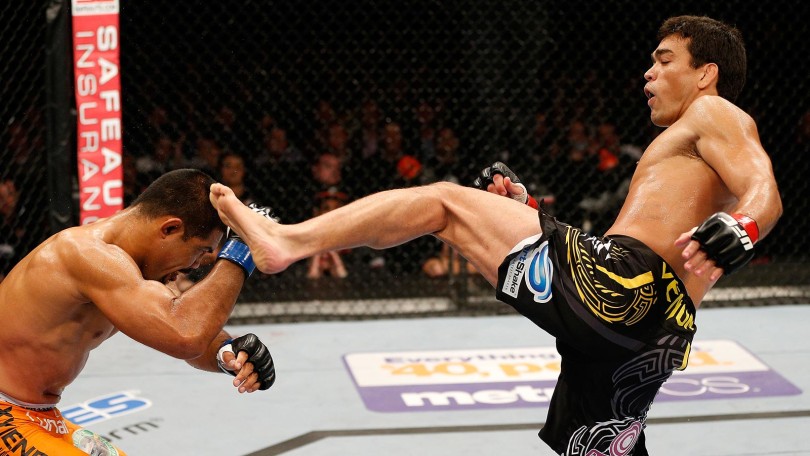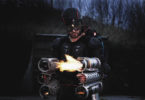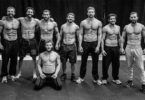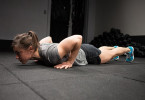So regular readers will know that I’ve recently been getting back into punching things – results of that coming soon. I’ve also been reading Tim Ferriss’ new book The 4-Hour Chef, which is mainly about cooking but partly about learning new skills, and includes two fascinating pages on the right sorts of questions to ask any expert to ensure you’re getting the biggest bang for your training buck. You can probably see where this is going.
As I mentioned in my previous post, much of my current striking practice is based on the works of Jack Slack, a striking coach and fight fan who’s been analysing how to hit people better since taking up karate at the age most people are still playing with stuffed animals. He’s a scholar of the fight game, an excellent technician, and I fully recommend checking out his books and blog – even if you aren’t interested in improving your own striking, it’ll give you a huge understanding and appreciation of the fight game. I’ve lost count of how many boxing commentators can’t explain why Pacquiao (for instance) is so good, but thanks to reading Jack’s posts, I’ve developed a much better understanding of that, and other questions.
Anyway: after I read the Ferriss stuff, I decided to go straight for the source. I sent Jack the suggested questions almost word-for-word, and he responded with the wealth of information below. It’s a long read, but I’d recommend it even if you aren’t into striking – it’s a fantastic example of how to break down and learn almost any skill.
Oh, and fun fact: it turned out Jack’s reading The 4-Hour Chef as well. Autodidacts think alike.
I have always enjoyed watching men who don’t excel physically dominate their opponents technically – so I studied guys like Jersey Joe Walcott, Archie Moore, James Toney. I think this is the best approach for anyone trying their hand at a new martial art or sport. I’m a novice in Brazilian Jiu Jitsu but in my time learning it I’ve looked more to what Caio Terra, Ryan Hall and other physically limited guys do rather than what the super explosive or strong guys can do.
The basic approach that I will always advocate is to take an angle. It’s always said but never much taught in the striking arts. I’ve been to so many boxing matches, kickboxing bouts and karate competitions where the two fighters simply attack each other head to head. This is what I refer to as fighting “on a line”. Obviously, if you’re constantly jumping out to the side to take an angle the opponent will try to catch you while you’re doing it, so fighting head to head is an important skill to learn, but it should always be engaged in with the idea of moving off line to land the real hurting shots later on. Even a bull when it fights another male of its own species will butt heads but be looking to move to the side of the opponent and gore their flank.
for it, not athletic, or for other reasons)
JS: Some of the best examples are the old timers of boxing whom I mentioned earlier. Jersey Joe Walcott wasn’t a huge puncher, was constantly overlooked for big opportunities, fought the best matches of his career around his late 30s and early 40s and never had the chance to train full time. He got by on developing a crafty style – he’d back up, change stances and turn his back just to get his opponents to chase – then he’d nail them with a hard right hand or left hook. In modern times Bernard Hopkins has shown true savvy in doing things at 40 that younger fighters are terrified to do such as leading with the right hand.
In MMA, Lyoto Machida is constantly given credit as being superhumanly fast but in truth he just has truly phenomenal timing and the ability to draw a predictable attack from his opponent which he can intercept. He’s a small guy for his weight class, and lacks the boxing and kickboxing versatility of many of his opponents. It’s almost entirely through elite timing, anticipation and drawing of the opponent that he wins his fights and those are skills which are far more simple to train than speed and combinations.
What are the biggest wastes of time?
The belief that full contact sparring is the only way that you will learn is a bizarre one which lingers. Body exclusive sparring (only body punches, chest punches and kicks to the body and legs) is great for learning to use range as long as you keep it sensible. Substitute jabs to the head with jabs to the sternum etc. and you’ve got a fantastic training method. Brendan Ingle’s fighters (Prince Naseem, Herol Graham, Junior Witter) all trained extensively with this method.
Equally, non-contact sparring as is done in Karate dojos can be of great use when approached properly. Obviously full sparring is enormously important and integral to proper training, but it certainly can’t be done every day. This is why forms of light sparring can and should be investigated. Sparring exists to practice movement, combinations, set ups and footwork against an opponent – more importantly, ANY form of sparring sharpens the reflexes and improves the movement.
A second myth which I am always looking to disprove is that all leading should be done with the jab. Personally, I have found a 80:20 jab to more exotic lead ratio to be much more effective and unpredictable. So for every few leads made with a jab you could throw a right hand lead (preferably a straight) or even lead with a left hook if you’re feeling flashy. The right hand lead developed a reputation as a sucker punch some time in the 60s as it is slower to the target than the jab, but properly set up with footwork it is a wonderful weapon which very few fighters practice counters for nearly enough to make them effective.
JS: Obviously having a good coach (or multiple if you’re lucky enough to have multiple gyms or styles near you) is the most important thing, but a great deal of strategy must be self taught because most coaches only deal with the basics. Edwin Haislet’s ‘On Boxing‘ is a masterpiece, as is ‘Boxing Simplified‘ which was written by John Walsh, a friendly rival of Haislet who coached another top high school team. Both of those are available online for free and worth more than anything produced in the last 20 years on boxing. Muay Thai Unleashed is a very good book, as is Fedor’s book. Anderson Silva’s book is pretty good but padded out with lots of gimmicky stuff.
Once you’ve got the basics of boxing from Haislet or Walsh, and have learned a few kicks it is time to start working on strategy. I’m sort of old school in this one; Sun Tzu, Miyamoto Musashi, even Machiavelli’s The Prince. Kazumi Tabata released a wonderful collection of excerpts from some strategic classics called ‘Secret Tactics’ which is a great entrance level book on strategy. The books to look at are the books that get you thinking about what you’re doing and don’t let you pretend that it is how fast you can throw the same 1-2-3 combo which everyone else is working on that determines your success.
The most important thing to do is to watch the best. Guys like Kid Chocolate learned to box by watching film – in fact Kid Chocolate used to have to go the library to watch grainy old footage of Jack Johnson on a terrible projector. Nowadays we have youtube! The best way to come up with new ideas is to watch what other top strikers have used to fluster their opponents. There’s a ridiculous number of fighters you could look at but it’s worth starting small. Think of 3 great boxers, 3 great kickboxers and 3 great MMA strikers, then sit down and watch some fights with a note pad.
JS: The most obvious one is a lack of discpline. Everyone loses the discipline eventually in a fight – dropping their hands for an instant or not angling out after an attack, or even attacking head on without a set up. To be honest adhering to correct striking principles is very tiring mentally and physically. The best guys in the world are the guys who can stay disciplined the longest – like Manny Pacquiao who can keep coming in and angling out even in the last round of a fight. It sucks to see a great technician or power puncher get caught in the last round of a fight because they couldn’t stay disciplined.
Another one is the complete absence of body work in most MMA matches and a seeming lack of respect for attrition work altogether. Jose Aldo and Jon Jones should have been enough to show the importance of targets that aren’t the head, but it’s still pretty rare to see a guy with good set ups for his low kicks or body shots. There is just far too much headhunting in MMA.
training look like? What if I had eight weeks? [full disclosure: I am not training for a fight, so don’t worry]
Another excellent strategy for BJJ guys, simply because a lot of them don’t train takedowns nearly as seriously as wrestlers and MMA fighters, is to get to work on the opponent’s lead leg. If you can get an opponent light on his lead leg, you bring his centre of gravity up and his ability to shuck off your attempts to clinch or take him down is going to be compromised. I personally will always sing the praises of inside low kicks and push kicks to the leg over the traditional low kick to the outside of the thigh. Nothing is as beautiful as a perfect outside low kick, but it’s also probably the easiest technique to get taken down off of.
JS: Develop a hard, jolting jab with the body weight behind it and work on landing it every time the opponent tries to punch.
If you have a technique which can make an opponent adjust the way they fight (say your jab keeps connecting as they step in, or your roundhouse kick is giving them a dead arm) they will be forced to adjust, and that is where openings for combinations come in.
If an opponent goes fully defensive or overly aggressive it is time to take an angle. If he’s covering, keep him busy and take an angle. If he’s chasing you, step off to the side and hit him as he turns to face you.
Never be afraid to tie up. The man who is willing to tie up and knows how has MASSIVE advantages over the man who doesn’t know how or refuses to. Tying up when something goes wrong (in boxing and kickboxing at least) is wiping the blackboard clean and saying ‘let’s try that again.’
HOMEWORK: Go and buy Jack’s books, or at least read his blog and work at Bloodyelbow.com, and support his training and studies. I get the feeling he’s going to become a big name over the next few years.






Interesting comments on sparring. My Thai trainers are pretty strict and obsessed with light sparring, only going hard as the fight gets closer. They prefer longer rounds of sparring to intensity. They also go on a 60/100 principle when sparring: 60% power to the head, 100% to the body. Some of my more experienced (Western) training partners had trouble with that.
I’m not the expert, but isn’t sparring very light quite traditional in Thailand? I believe that the Thais fight so often (sometimes once a fortnight) that they can’t afford to get injured in sparring. Having the discipline to go hard to the body but not the head sounds tough, too. Thanks for the input.
Yes, they do. And yes, it’s hard to reconcile the 2 powers or speeds.
[…] hurt from a body kick, MacDonald landed a hard body punch that doubled Penn over. Gif of that HERE I certainly feel better about the lack of bodywork in MMA that I spoke about in a recent interview. It is a testament to Penn’s toughness that he was able to make it to the end of the round, […]
Amazing, It’s great to learn about Jack Slack’s process and even more awesome to learn that he is reading Tim Ferriss’s book also!
Good stuff, thanks! Jack Slack’s analyses are excellent.